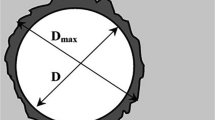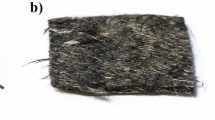Abstract
New biocomposites are increasingly being developed and applied in engineering and manufacturing. The reinforcement type used in biocomposite is one of the major factors that greatly affect the machinability of biocomposite. This study investigated the drilling of two biocomposites (polypropylene-based biocomposite reinforced with biocarbon M1 (30 wt% biocarbon + PP/POE/MAPP) and chopped miscanthus fibers M2 (30 wt% miscanthus + PP/POE/MAPP)). A full factorial design was used for this study. The effects of drilling parameters and reinforcement types on surface roughness, thrust force, specific cutting energy, fine particles, and ultrafine particle generation were measured and analyzed. The results show that the thrust force and specific cutting energy during drilling of biocomposite M1 is bigger than that of biocomposite M2 under the same cutting conditions. However, the surface roughness and fine dust emitted when drilling biocomposite M1 are smaller than those from biocomposite M2, respectively. The reinforcement types of biocomposite, cutting parameters and drill diameter greatly affected fine particles emission. Meanwhile, the cutting conditions are not statistically significant for ultrafine particle generation during dry drilling of both biocomposites.






























Similar content being viewed by others
References
Peças P, Carvalho H, Salman H, Leite M (2018) Natural fibre composites and their applications: a review. J Compos Sci 2:66
Vinayagamoorthy R, Rajmohan T (2018) Machining and its challenges on bio-fibre reinforced plastics: a critical review. J Reinf Plast Compos 37:1037–1050
Rezghi Maleki H, Hamedi M, Kubouchi M, Arao Y (2019) Experimental study on drilling of jute fiber reinforced polymer composites. J Compos Mater 53:283–295
Bajpai PK, Singh I (2013) Drilling behavior of sisal fiber-reinforced polypropylene composite laminates. J Reinf Plast Compos 32:1569–1576
Debnath K, Singh I, Dvivedi A (2017) On the analysis of force during secondary processing of natural fiber-reinforced composite laminates. Polym Compos 38:164–174
Yallew TB, Kumar P, Singh I (2016) A study about hole making in woven jute fabric-reinforced polymer composites. J Materials Design and Applications 230:888–898
Debnath K, Singh I, Dvivedi A (2014) Drilling characteristics of sisal fiber-reinforced epoxy and polypropylene composites. Mater Manuf Process 29:1401–1409
Rezghi Maleki H, Hamedi M, Kubouchi M, Arao Y (2019) Experimental investigation on drilling of natural flax fiber-reinforced composites. Mater Manuf Process 34:283–292
Ismail SO, Dhakal HN, Dimla E, Beaugrand J, Popov I (2016) Effects of drilling parameters and aspect ratios on delamination and surface roughness of lignocellulosic HFRP composite laminates. J Appl Polym Sci 133. https://doi.org/10.1002/APP.42879
Choudhury MR, Srinivas MS, Debnath K (2018) Experimental investigations on drilling of lignocellulosic fiber reinforced composite laminates. J Manuf Process 34:51–61
Ismail SO, Dhakal HN, Popov I, Beaugrand J (2016) Comprehensive study on machinability of sustainable and conventional fibre reinforced polymer composites. Eng Sci Technol Int J 19:2043–2052
Tran DS, Songmene V, Ngo AD, Kouam J, Rodriguez-Uribe A, Misra M, Mohanty AK (2020) Experimental Investigation on machinability of polypropylene reinforced with miscanthus fibers and biochar. Materials 13:1181
Voss R, Seeholzer L, Kuster F, Wegener K (2017) Influence of fibre orientation, tool geometry and process parameters on surface quality in milling of CFRP. CIRP J Manuf Sci Technol 18:75–91
Chegdani F, Mezghani S, El Mansori M, Mkaddem A (2015) Fiber type effect on tribological behavior when cutting natural fiber reinforced plastics. Wear 332:772–779
Chegdani F, El Mansori M (2019) New multiscale approach for machining analysis of natural fiber reinforced bio-composites. J Manuf Sci Eng 141(1):011004-1–011004-9
Cococcetta NM, Pearl D, Jahan MP, Ma J (2020) Investigating surface finish, burr formation, and tool wear during machining of 3D printed carbon fiber reinforced polymer composite. J Manuf Process (in press)
Haddad M, Zitoune R, Eyma F, Castanie B (2014) Study of the surface defects and dust generated during trimming of CFRP: influence of tool geometry, machining parameters and cutting speed range. Compos A: Appl Sci Manuf 66:142–154
Marani M, Songmene V, Kouam J, Zedan Y (2018) Experimental investigation on microstructure, mechanical properties and dust emission when milling Al-20Mg2Si-2Cu metal matrix composite with modifier elements. Int J Adv Manuf Technol 99:789–802
Saidi M, Songmene V, Kouam J, Bahloul A (2019) Study of surface quality and dust particles emission and dispersion during dry polishing of granite. Int J Adv Manuf Technol 104:4675–4684. https://doi.org/10.1007/s00170-019-04166-3
Nassar MM, Arunachalam R, Alzebdeh KI (2017) Machinability of natural fiber reinforced composites: a review. Int J Adv Manuf Technol 88:2985–3004
Sheikh-Ahmad JY (2009) Machining of polymer composites, vol 387355391. Springer, Berlin
Dhaouadi T (2018) Caractérisation et modélisation des propriétés mécaniques des biocomposites à fibres courtes aléatoires, Master of Applied Science, École de technologie supérieure, ÉTS, Montreal, Canada, p 138
Muthuraj R, Misra M, Defersha F, Mohanty AK (2016) Influence of processing parameters on the impact strength of biocomposites: a statistical approach. Compos A: Appl Sci Manuf 83:120–129
Wang T, Rodriguez-Uribe A, Misra M, Mohanty AK (2018) Sustainable carbonaceous biofiller from miscanthus: size reduction, characterization, and potential bio-composites applications. BioResources 13:3720–3739
Saidi M, Songmene V, Kouam J, Bahloul A (2015) Experimental investigation on fine particle emission during granite polishing process. Int J Adv Manuf Technol 81:2109–2121
Muthuraj R, Misra M, Mohanty AK (2017) Biocomposite consisting of miscanthus fiber and biodegradable binary blend matrix: compatibilization and performance evaluation. RSC Adv 7:27538–27548
Author information
Authors and Affiliations
Corresponding author
Additional information
Publisher’s note
Springer Nature remains neutral with regard to jurisdictional claims in published maps and institutional affiliations.
Rights and permissions
About this article
Cite this article
Tran, D.S., Songmene, V., Ngo, A.D. et al. Effects of reinforcements and cutting parameters on machinability of polypropylene-based biocomposite reinforced with biocarbon particles and chopped miscanthus fibers. Int J Adv Manuf Technol 110, 3423–3444 (2020). https://doi.org/10.1007/s00170-020-06070-7
Received:
Accepted:
Published:
Issue Date:
DOI: https://doi.org/10.1007/s00170-020-06070-7




